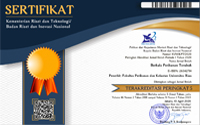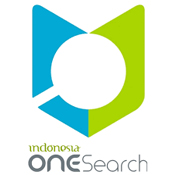The Impact of Different Lighting with the Use Of Palm Oil Liquid Waste for the Production of Microalgae Chlorella sp. at Ptpn V Sei Galuh, Kampar Regency, Riau Province
Abstract
Keywords
Full Text:
PDFReferences
Abdurrachman, O., Mutiara, M. & Buchori, L. (2013). Peningkatan Karbondioksida dengan Mikroalga (Chlorella vulgaris, Chlamydomonas sp., Spirulina sp.) Dalam Upaya Untuk Meningkatkan Kemurnian Biogas. Jurnal Teknologi Kimia dan Industri, 2 ( 4), 212-216.
Badan Pusat Statistika Provinsi Riau. (2020). Statistik Kelapa Sawit Provinsi Riau. Pekanbaru : Badan Pusat Statistika Provinsi Riau.
Boroh, R. (2012). Pengaruh Pertumbuhan Chlorella sp. pada Beberapa Kombinasi media Kultur: Makassar, Biologi FMIPA. UNHAS. (Tidak Diterbitkan).
Choochote, W., Paiboonsin, K. Ruangpan, S. & Pharuang , A. (2012). Effects of Urea and Light Intensity on the Growth Of Chlorella sp: Bangkok,The 8th International Symposium on Biocontrol and Biotechnology.
Dahril, T, A. Mulyadi, Efawani & M.S. Riza. (2016). Pemanfaatan Limbah Cair Pabrik Kelapa Sawit Sebagai Media Kultur Mikroalga (Chlorella sp.) dalam Fotobioreaktor untuk Mencegah Pencemaran Lingkungan Perairan di Provinsi Riau. Laporan Hasil Penelitian MP3EI. Universitas Riau. (Tidak Diterbitkan).
Facta, M., Zainuri, M. Sudjadi & Sakti, E. P. (2006). Pengaruh Pengaturan Intensitas Cahaya yang Berbeda Terhadap kelimpahan Dunaliella sp. dan Oksigen Terlarut dengan Simulator TRIAC dan Mikrokontroler AT89S52. Jurnal Ilmu Kelautan, 11 (2) , 67-71.
Fadilla, Z. (2010). Pengaruh Konsentrasi Limbah Cair Tahu terhadap Pertumbuhan Mikroalga Scenedesmus sp. [Skripsi]. Fakultas Sains dan Teknologi. Jakarta : Universitas Islam Negeri Syarif Hidayatullah.
Istirokhatun, T., Dimas, A. & Praharyawan, S. (2017). Pemanfaatan Air Lindi TPA Jatibarang sebagai Media Alternatif Kultivasi Mikroalga untuk Perolehan Lipid. Jurnal Teknik Lingkungan, 6 (1), 1-15.
Kawaroe, M. (2010). Mikroalga, Potensi dan Pemanfaatannya untuk Produksi Bio Bahan Bakar. Bogor: IPB Press.
Kusdarwati, R., Bustaman, R. H. & Arief, M. (2011). Pengaruh Perbedaan Warna Cahaya Terhadap Pertumbuhan Kultur Spirulina sp. Ilmiah Perikanan dan Kelautan, 3 (2), 183-191.
Kusriningrum. (2008). Perancangan Percobaan. Surabaya : Airlangga University Press.
Lakitan, B. (1994). Dasar-Dasar Klimatologi. Jakarta : PT. Raja Grafindo Persada.
Mohammed, B., El-Ayoty, Y. A., Abomohra, E. F., El-Ghany, S.A., & Esmael,A. (2013). Optimization of Growth and Lipid Production of the Chlorophyte Microalga Chlorella vulgaris as a Feedstock for Biodiesel Production. Journal of World Applied Scine, 28 (11), 1536-1546.
Rambe, S. M., Iriany & Irvan.( 2014). Pengaruh Waktu Tinggal Terhadap Reaksi Hidrolisis pada Pra-Pemuatan Biogas dari Limbah Cair Kelapa Sawit. Jurnal Dinamika Penelitian Industri, 25 (1), 23-30.
Utami, A. D. (2020). Pengaruh Perbedaan Konsentrasi Limbah Cair Kelapa Sawit Terhadap Pertumbuhan dan Komposisi Kimia Chlorella sp.[Tesis] Program Pascasarjana. Fakultas Perikanan dan Kelautan. Universitas Riau. Pekanbaru.
Wardani, M. (2018). Pengaruh Pemberian Pupuk Cair Limbah Ikan Lemuru Terhadap Kandungan Karotenoid Spirulina platensis. [Skripsi]. Universitas Airlangga.
Wardhana, (1995), Dampak Pencemaran Lingkungan. Yogyakarta: Andi offset.
Yolanda, Y. 2016. Pemanfaatan Limbah Cair Biogas Pabrik Kelapa Sawit Untuk Produksi Mikroalga Chlorella sp. [Skripsi]. Fakultas Perikanan danKelautan. Universitas Riau. Pekanbaru.(Tidak Diterbitkan).
DOI: http://dx.doi.org/10.31258/terubuk.51.1.1925-1934
Refbacks
- There are currently no refbacks.
Copyright (c) 2023 Tuti Maisarah Br. Siregar, Tengku Dahril, Asmika Harnalin Simarmata

This work is licensed under a Creative Commons Attribution 4.0 International License.












